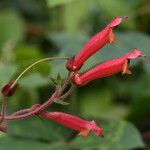Herbs or somewhat suffruticose; tuber woody, to 8 cm in diam., ca. 4 cm thick; stems erect, to 1 m tall, green or reddish with reddish longitudinal lines in the internodes, villous, especially toward the apex, with patent and appressed hairs, the internodes to 10 cm long; branches numerous, but often short. Leaves opposite, oblong, obovate, or elliptic, 4.5-9.5 cm long, 1-4 cm wide, thickened from dense vestiture, the apex acute, the base attenuate into the petiole or acute, crenate, above green, densely villous or hirsute, with broad based trichomes, below lighter or yellowish green, more densely pubescent; petioles 1-4 cm long, villous. Inflorescernces axillary, but appearing racemiform and terminating the stem, leafy below, the leaves reduced to bracts above; peduncles 1-5 short or lacking; bracts 2, small; pedicels ca. 1 cm long, elongating in fruit, ascending, green or reddish, villous. Flowers showy; calyx campanulate, green or reddish, the tube 3-4 mm long, ca. 7 mm wide, the lobes broadly triangular, erect, 4-7 mm long, 2-5 mm wide, the apex acute, pilose and glandular on both sides; corolla red or red orange outside, often yellowish within, the tube 3-4 cm long, the base gibbous, ca. 7 mm wide, then narrowing to ca. 4 mm wide, broader at the middle, before narrowing just below the limb, the outside hirsute, the inside glabrous, the limb oblique, bilabiate, the upper lobes united, erect, ca. 1 cm long and wide, the lateral and the basal lobes somewhat reflexed, ca. 2 mm long, ca. 7 mm wide; stamens nearly equalling the upper corolla lobes, the filaments curved, adnate to the base of the corolla tube, 3-4 cm long, glabrous to pubescent, the anthers coherent at the apices, 1.5-2.5 mm long; disc glands 4 or 5, with 2 posterior glands large and connate; ovary conic, pubescent, the style curved, equalling the stamens, pilose. Capsules ovoid, ca. 1 cm long, apex acuminate; seeds fusiform or oblong, ca. 1 mm long, light brown, striate, twisted. Chromosomes n = 13 (as Rechsteineria warszewiczii from cultivation; Clayberg, 1967).
More
Terrestrial herb or subshrub, to 1 m tall. Stem sappy becoming subwoody, erect, pubescent to villous, especially towards apex. Leaves equal or subequal in a pair; petiole 0.1-4 cm long, villous; blade papyraceous when dry, oblong, obovate, or elliptic, 2.5-9.5 x 1-4 cm, margin crenate, apex acute, base attenuate into petiole or acute, above tomentose, below tomentose. Flowers 1-5, thyrsoid; peduncle very short or lacking, 0-0.2 cm long, pubescent; pedicel 0.5-4 cm long, pubescent to villous. Calyx campanulate, green or reddish, lobes connate at base, tube 0.3-1 cm, free portion of lobes erect, subequal, broadly triangular, 0.4-0.7 x 0.2-0.6 cm, margin entire, apex acute to acuminate, outside and inside pubescent to pilose and glandular; corolla erect in calyx, red or red-orange outside, 2.7-4.6 cm long, tube cylindric, 3-4 cm long, base dorsally gibbous, ca. 0.7 cm wide, middle broader, throat narrowed just below limb, 0.5-0.8 cm wide, outside pubescent to hirsute, inside glabrous, limb 1.2-2.0 cm wide, lobes unequal, upper lobes connate into a hood, erect, ca. 1 x 1 cm, margin entire, lateral lobes erect, rounded to truncate, 0.1-0.3 x 0.3-0.6 cm, margin entire, basal lobes erect, broadly rounded, ca. 0.2 x 0.4-0.6 cm, margin entire; stamens exserted, inserted at base of corolla tube; ovary conic, ca. 0.4 x 0.3 mm, pubescent, style ca. 4 cm long, pubescent to pilose, stigma stomatomorphic. Mature capsule brownish, ovoid, ca. 1 x 0.4-0.7 cm.

